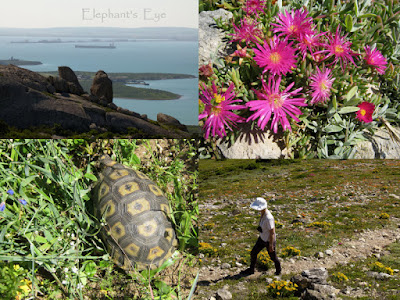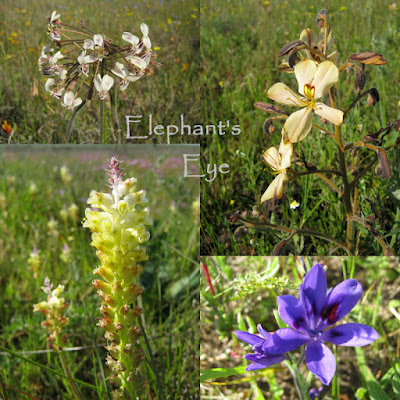Postberg and Darling for spring flowers in September 2014
by Diana Studer
- gardening for biodiversity
in Cape Town, South Africa
That September we went to Postberg Flower Reserve in the West Coast National Park for the spring flowers. Free
entry with our Wild Card. Stern notices
say Stay In Your Car, except at the picnic and parking spots. In 2010 we
enjoyed walking the Bakoor
Trail. Disconcertingly we were no longer allowed to walk into that rocky
view.
Didelta carnosa var. Tomentosa leaves covered
in white hairs, this daisy shrublet grows very close to the sea at
Plankiesbaai.
From Postberg Flower Reserve you look across Langebaan
Lagoon (nature conservation) to Saldanha Bay with ships taking iron ore brought
from Sishen
by train. Daisies, bulbs and succulents (electric pink vygie). An angulate
tortoise kept me company. We climbed up the hill with the flowers.
 |
| Pelargonium fulgidum, Moraea tripetala, Dipogon lignosus Zaluzianskya Salvia africana-lutea, Sutherlandia frutescens 2014 |
(Wish list) Scarlet Pelargonium fulgidum with lush
silver fur on its green leaves, also grows at Cape
Columbine. Blue and yellow Moraea tripetala an iris in tiny
feathered perfection. Purple and pink pea flowers of Dipogon lignosus.
Five distinctively forked petals, common name drumsticks, is Zaluzianskya (can't
ID a pink one?) Strandsalie
here living up to its name; Salvia africana-lutea grows in my
garden. Metallic pods and leaves on Sutherlandia frutescens.
Gazania peacock marked with chocolate and cream at
the base of its petals. Didelta carnosa var. tomentosa. Two yellow
daisies. Dimorphotheca pluvialis rain daisies are white with a purple
heart.
Since we went that way home, we stopped at Tinie
Versfeld Wildflower Reserve outside Darling. Swartland Renosterveld grows
on fertile clay soils, almost covered with wheat fields today. 4% survives;
this reserve is part of 1.6% which is conserved.
Romulea tabularis blue stars with a golden heart (I
have a name for one of my potted treasures!) Soft yellow Sparaxis bulbifera grows
with wet feet.
Pelargonium triste clove scented at night. 'John Tradescant, took Pelargonium
triste to England in 1632, one of the first pelargoniums from the Cape
to be collected and cultivated' - PlantZAfrica. Wachendorfia
brachyandra has red roots and golden flowers. Lachenalia pallida cream
with green tips like a snowdrop. Babiana angustifolia blue with violet
details on the upper petals.
We have so many
different flowers that at the end of the day, I slide into SEEN those, but what
is THAT large lonely white flower whose petals were neatly edged with pinking
shears? Monsonia speciosa
is one of our few true geraniums to set against a wide spectrum of
pelargoniums.
Late afternoon in
Darling, setting out Geissorhiza darlingensis was open, but as we
returned half an hour later, the flowers were tucked up for a cool evening. In
the iris family, yellow wine cup is only found at Tinie Versfeld, on damp
granite soil. We did walk carefully, appreciating the boardwalks!
We saw the Clanwilliam
dam overflowing in August 2014. That
dam is now at 41% (after winter rain) and the flower
show was cancelled as the wild flowers are battling to survive at all, let
alone sustainably harvest a generous display.
Interactive
chart from the University of Cape Town's Climate System Analysis Group. Looking
back at rainfall figures over recent years it is hard to believe that only three
years ago we took fields washed in flowers for granted! (20 percentile = 1 in 5
observations fall below the blue band = 3 in 5, 80 = another 1 in 5 above)
Currently we follow the pattern of 1994, will
we get that spike??
I invite you to
join us at Elephant's Eye on False Bay. Please subscribe as you prefer
via Feedly,
or Bloglovin,
or Facebook
Pictures by Diana
and Jürg Studer
Teal blue text is
my links.
To read comments if
you are in email or a Reader,
first click thru to the blog)
Thanks for comments
that add value. Maybe start a new thread of discussion? BTW your comment won't
appear until I've read it. No Google account? Just use Anonymous, but do leave
a link to your own blog. I would return the visit, if I could...
I welcome comments
on posts from the last 2 months.










I remember asking this before, but I forgot. Why can you only leave the car at the picknic and parking spots?
ReplyDeleteThe roads are narrow and this year I saw daunting pictures of the tailback on the national road, HORDES of people waiting to get in. Within the park the roads are just wide enough to allow two streams of traffic - but no space to park, without smashing the flowers.
DeleteDiana, all those flowers are gorgeous and the landscape is breathataking! I see the pictures and want to be there! I always imagined that Cape Town would be as humid as here considering the similar latitude but I see it's considerably drier.
ReplyDeleteFor a humid sub-tropical climate you need to head up the Indian Ocean (warm current) to Durban. Where today they sadly have appalling storms, floods and wind damage.
DeleteOh thank you for the sunshine, landscapes, beautiful colourful flowers and a tortoise. Put a smile on this weary face xx
ReplyDeleteYou are very welcome!
DeleteBeautiful wildflowers, so colorful and plentiful it's hard to believe they are struggling.
ReplyDeleteThe rainfall chart looks grim, I hope you get more rain before summer. We had two years of drought and are back on track recently.
We are at the nasty (post winter rain) side of a 3 year drought.
DeleteBeautiful scenery and stunning flowers. It's sad that so little of the Swartland Renosterveld is conserved (not that the US sets any standards with respect to conservation, particularly under the current administration). I'm also sorry that drought still plagues you and I do hope you get that hoped for spike in rainfall soon.
ReplyDeleteIt's always thrilling seeing your wildflower posts, especially as your region is so rich in bulbs - which I have always loved. I hope you get a surge in rainfall to bring the water levels up and the wildflowers back!
ReplyDeleteThe bulbs of the Cape region are marvelous; we are lucky to be able to grow some of them here. Babiana, Sparaxis. I hope you and those precious wild plants get that spike of rainfall. I've seen S. africana-lutea for sale here, does it grow large in your garden?
ReplyDeleteJust too many humans crowding out the marvels that are other species. This goes for the world, not just SA or California.
Salvia africana-lutea is a sprawling hip-high shrub. You can keep it trimmed back and the leaves smell good. Burnt terracotta flowers are an unusual colour. Nectar for our sunbirds and your hummingbirds. http://pza.sanbi.org/salvia-africana-lutea
DeleteThe pza.sanbi.org website is really good. I've learned a lot from it. The recent "facelift" has included a lot more information.
DeleteWildflowers in Scotland are, shall we say subtle but treasured. In your part of the world well and truly in your face
ReplyDelete(fabulous)
Your wild flowers always remind me of my mother's time growing up in the Cape & her life long love of Cape wild flowers... I hope many species she loved have survived, especially without protection. Are you keeping records of your photos of wild flowers to be kept for future generations? I hope rain starts to fall regularly again, we have not had our usual rainfall this year.
ReplyDeleteThere are various scientists doing formal research. While the blog remains on the web - this flower - this 'place' - this month in this year - is searchable.
DeleteThat Salvia African lutea is one of my favourite plants. I tried it in the garden once, but it didn't work out and we had to part company. It's lovely to see it at home. TV Flower Reserve really special place, so sad only 1.6% but I suppose we must be grateful for that, it could be worse, like 1 or 0%.
ReplyDeleteanother piece added recently
Deletehttp://overbergrenosterveld.org.za/first-conservation-easement/
which I hope to visit one day
I also hope to visit it one day, but you are far more likely to make it than me, so I look forward to seeing it through your words and lenses.
DeleteThose reserves full of wildflowers look amazing, what a shame you couldn't walk in the first one. It must be so inspiring discovering new plants that you could try in your own garden. Sarah x
ReplyDeleteIt is a want want want walk ;~)
DeleteI would love to be able to visit your beautiful area in spring. So many of the UK's garden flowers originate in the Cape region. Even with less conservation than you would wish the area is so rich. Like you we have had so little rain in the last year; the early rains in September gave me hope but October has been completely without rain and I notice that seedlings that have germinated are flopping and look like they will die, I even watered them, but I can't do that long term! I hope you receive some rain soon.
DeleteHeartbreaking to try and pull tiny seedlings thru a drought.
DeleteSo colourful, this is an amzing landscape!
DeleteYour wildflowers are amazing, Diana. I think I remember that posting because of the angulate tortoise. At that time my grandchildren found a tortoise in our garden, under the woodpile. Sadly, we haven't seen any since then. Praying for your spike in rainfall! P. x
ReplyDeleteand I hope the baby tortoises we found in our Porterville garden survived the new owners.
DeleteI'm in love with Romulea tabularis. I'm finding the changes in our weather patterns alarming -- record warmth here, with the second year in a row of moderate drought. And still our federal government buries its collective head in the sand.
ReplyDeleteThat Romulea is very similar to a blue flowering bulb from the USA.
Delete